28 October 2015
This slow motion video depicts the motion of the brain during an impact event. Concussions are the most common form of traumatic brain injury and are a growing concern in many contact sports.
During severe events, the cerebrospinal fluid that normally provides a cushion for the brain is unable to prevent physical collision with the skull. The pathophysiology of concussions is extremely complex and involves impaired neurotransmission, deregulation of ion gradients, energy usage, and metabolism, and reduction in cerebral blood flow.
Source: https://vine.co/v/eUXxn20mKZW (UCLA)
#ScienceGIF #Science #GIF #UCLA #Neuroscience #Brain #Concussion #TraumaticBrainInjury #TBI #Biology #Medicine #Impact #Sports
View Original Post on Google+

27 October 2015
This rendering depicts a star being torn apart by the immense tidal forces of a massive black hole. Much of the stellar debris is sucked into the singularity while some matter is flung outwards at very high speeds.
This animation was based off a real event (ASASSN-14li) observed by NASA’s Chandra X-ray Observatory, Swift Gamma-ray Burst Explorer, and ESA/NASA’s XMM-Newton in November 2014.
Source: https://youtu.be/hu6hIhW00Fk (NASA Goddard)
#ScienceGIF #Science #GIF #NASA #Goddard #Space #BlackHole #Star #EventHorizon #Relativity #Singularity #Simulation #Computer
View Original Post on Google+

26 October 2015
The Steward Observatory Mirror Lab is located beneath the University of Arizona football stadium and is the only facility on the planet capable of producing large-scale mirrors for our most advanced telescopes. Each mirror starts as individually placed chunks of glass that are melted down within an enormous heated chamber. The honeycomb structure allow for a more lightweight mirror while still retaining the requisite stiffness. The mirror will then be polished for months to achieve the desired parabolic shape and smoothness.
Source: https://youtu.be/g0L1tiFzse0
#ScienceGIF #Science #GIF #Telescope #Mirror #Optics #GiantMagellan #GMT
View Original Post on Google+
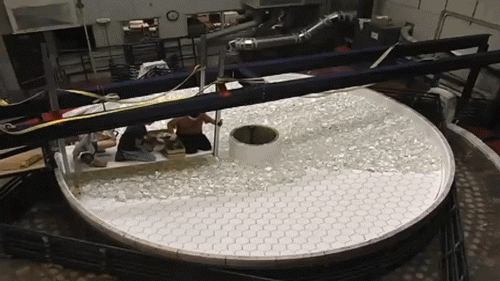
23 October 2015
Hurricane Patricia made landfall around 7:30pm ET just north of Manzanillo, Mexico as a Category 5 hurricane. It is only the second Category 5 hurricane to make landfall from the Pacific Ocean in recorded history.
Prior to landfall, the Hurricane Patricia set the lowest-measured pressure (880 mbar) of any hurricane in the Eastern Pacific or Atlantic Oceans. Pressure is used as a general measure for the strength of a storm (lower = stronger).
The storm had sustained winds over 200mph, making it the strongest hurricane ever recorded when ranked by wind speed. The risk for catastrophic damage along the Mexican coast is very much a concern.
Source: http://www.intellicast.com/Storm/Hurricane/Active.aspx?storm=1&type=infrared&animate=true&enlarge=true
#ScienceGIF #Science #GIF #Hurricane #HurricanePatricia #Mexico #Landfall #Storm #Meteorology #Satellite #Rain #Waves #Surge #Wind #Storm
View Original Post on Google+

22 October 2015
A cloud chamber is a sealed container filled with supersaturated alcohol vapor that can be used to detect ionizing radiation. The piece of uranium undergoes radioactive decay through the emission of alpha particles (Helium-4 nuclei). As these charged particles pass through the vapor, they can interact with molecules to form ions. The alcohol vapor then condenses around these ions resulting in the visible tracks though the vapor.
Source: https://youtu.be/ZiscokCGOhs
#ScienceGIF #Science #GIF #Radioactive #Radioactivity #Uranium #Alcohol #Cloud #CloudChamber #Ions #Particles #Trails
View Original Post on Google+
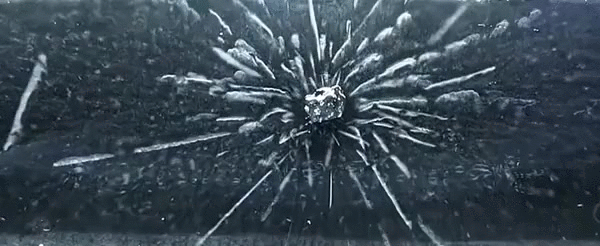
21 October 2015
In the microgravity environment aboard the International Space Station, an effervescent tablet (antacid) behaves a little differently than back here on Earth. Without the effect of buoyancy, the gases released by the tablet do not rise upwards and simply expand outwards within the colored water. Once the pressure within a bubble is sufficient to overcome the surface tension of the water, it bursts, resulting in the undulations spreading across ball of water.
Source: https://youtu.be/bKk_7NIKY3Y (NASA)
#ScienceGIF #Science #GIF #NASA #Space #ISS #SpaceStation #InternationalSpaceStation #4K #ZeroGravity #Gravity #Weightless #Liquid #Antacid #Water #Physics #Reaction
View Original Post on Google+
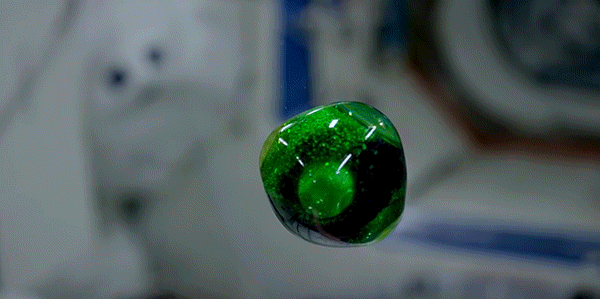
9 October 2015
This Disney Research technical demo showcases a real-time augmented reality coloring book. It allows the user to color a cartoon character, which is then imaged by a tablet and used to synthesize a textured 3D model. The software can track the deformation of the paper and accommodate for its motion.
Source: https://youtu.be/SWzurBQ81CM
#ScienceGIF #Science #GIF #Disney #ComputerScience #ComputerVision #AugmentedReality #Drawing #Research #Tablets #ColoringBook #App #Texturing #ImageProcessing
View Original Post on Google+

2 October 2015
THIS REACTION IS EXTREMELY DANGEROUS! DO NOT ATTEMPT!
The basic ingredients required for an explosive reaction are an oxidizer and a fuel. This reaction combines commercially available pool chlorine (calcium hypochlorite) as the oxidizer and brake fluid (polyethylene glycol) as the fuel. Upon mixture, the reaction takes several seconds to initiate. As it progresses, an immense amount of energy is released as the oxidizer consumes all the fuel. The heat is sufficient to melt the plastic bottle and produces highly flammable toxic gases that eventually ignite in a flash of light. Calcium hypochlorite is converted into calcium chloride (salt) as it oxidizes the polyethylene glycol.
It is believed that the polyethylene glycol undergoes molecular fragmentation into the organic molecules ethylene, acetaldehyde, and formaldehyde. Just 10mL of brake fluid can produce an estimated 4L of flammable gases that are readily ignited by the heat of the oxidation reaction. The other components of brake fluid undergo other (unknown) reactions, likely facilitated by the energy released from the oxidation reaction.
Learn More: http://www.sciencemadness.org/talk/files.php?pid=390597&aid=37261
Source video has been removed from YouTube
DON ‘T TRY THIS
#ScienceGIF #Science #GIF #Chemistry #Reaction #RxN #Exothermic #Oxidation #Chlorine #PEG #BrakeFluid #Flame #Heat #Melting #Dangerous #Toxic
View Original Post on Google+
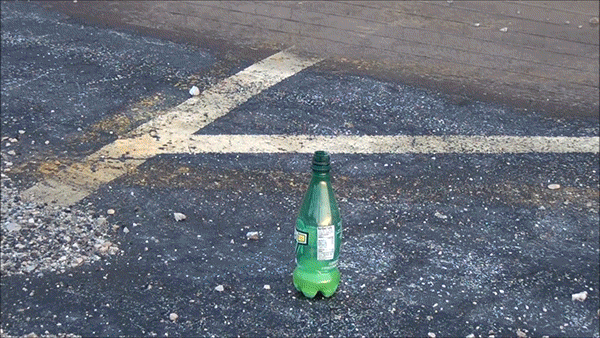
30 September 2015
The Barking Dog reaction is a popular chemistry demonstration that produces a loud ‘woof’ noise similar to the sound of a dog’s bark (check out the source video). The exothermic reaction involves igniting a mixture of carbon disulfide (CS2) and nitrous oxide (NO2) gas inside a large test tube. A brilliant blue flame is produced as the reactants decompose during combustion.
The slow motion video shot at 3000fps reveals oscillations in the flame through the test tube. As the reactants combust, a pressure wave is created that travels down the tube. Upon reaching the bottom of the tube, the pressure wave is reflected back upwards, causing the flame to be pushed up. This expansion and contraction continues until all the reactants in the test tube are consumed.
Source: https://youtu.be/c3fJRRCAIdk
#ScienceGIF #Science #GIF #Reaction #BarkingDog #SlowMotion #HighSpeed #Exothermic #Chemical #Chemistry #Combustion #Flame #Oscillation #Cool
View Original Post on Google+
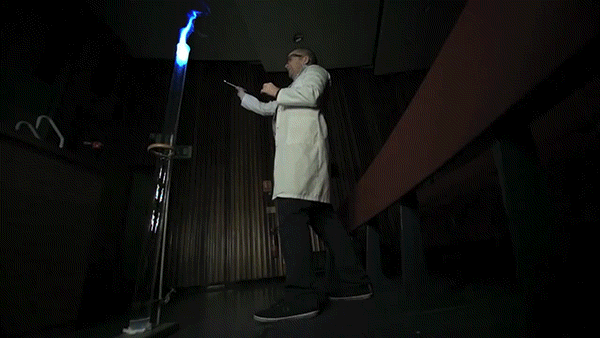
29 September 2015
The Whoosh Bottle is a classic classroom science demonstration of the energy released during combustion. A small volume of alcohol (ethanol, methanol, propanol) is poured into a polycarbonate bottle, which is then sealed to contain the vaporizing liquid. After a short wait, the stopper is removed and a flame placed near the opening to ignite the alcohol fumes. The name “Whoosh Bottle” comes from the roaring sound produced as the flame works its way through the bottle consuming all the vaporized alcohol.
Source: https://youtu.be/0jCCP6rUEsc
#ScienceGIF #Science #GIF #Whoosh #WhooshBottle #Combustion #Alcohol #Bottle #Fire #Flame #Classroom #Demonstration
View Original Post on Google+











